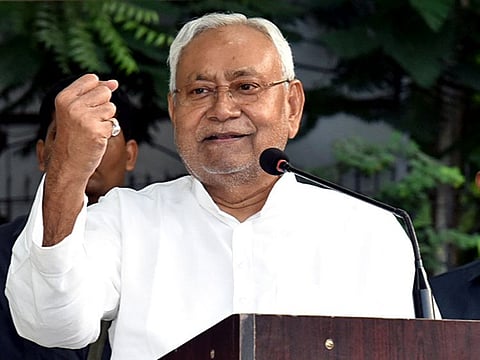Why Nitish Kumar changes alliance partners every two years
Bihar chief minister has taken oath of office for a record nine times since 2000

On the streets of Patna, it didn’t come as a surprise when Chief Minister Nitish Kumar attacked the Congress party for never giving the Bharat Ratna award to the late Karpoori Thakur.
It was common talk for many days in Patna’s political circles that Nitish Kumar was about to switch back to his old love, the Bharatiya Janata Party.
You might think there would be some end to Nitish Kumar’s flip-flops. In Patna, people know their CM well. It’s always a question of when, not if, Nitish Kumar will change partners.
His moves make it clear he is very much playing the games he’s known for. All options must always be kept open for Nitish Kumar. The surprise is when he does not surprise.
Target: Lok Sabha
The motivations are obvious. As the Lok Sabha elections are only weeks away, Nitish Kumar could see the writing on the wall. Despite theoretically having a strong demographic base for the INDIA alliance in Bihar, he could see the Modi wave.
His party would have done badly in the Lok Sabha elections. The lack of public enthusiasm for the caste census has proved that caste alone won’t save the INDIA alliance in Bihar’s 40 Lok Sabha seats.
He can always return to RJD-Congress before the next Vidhan Sabha elections in November 2025, if need be.
Nitish Kumar gets the best out of the RJD-Congress and the BJP by constantly playing one against the other. It’s a bit like having two lovers. When you get bored of one, when one starts taking you for granted, you move in with the other one.
The joke is on the RJD-Congress and the BJP, that they call Nitish Kumar names and yet they’re ready to return to power with him at a moment’s notice. Shows you how it’s all about power. Ideology, ethics, morality, principle, loyalty are all words in the dictionary and no more.
Peripatetic Nitish
Here’s the recap. In 2013-14, Nitish Kumar of the Janata Dal (United) dumped his long-time ally, the BJP. In 2015 he made an unlikely alliance before the assembly elections with his old rival, Lalu Yadav of the Rashtriya Janata Dal.
In 2017, he dumped the RJD and went back to ally with the BJP.
He contested the 2020 Bihar assembly elections in alliance with the BJP but in August 2002, again changed partners to go back with Lalu Yadav, again making Lalu’s son Tejashwi the deputy chief minister.
Now, in 2024, he seems to be ready to go back with the BJP. Ironically, the pivot chosen seems to be the Bharat Ratna for Karpoori Thakur, who as chief minister in the 1970s had started the policy of caste-based reservations but whose government fell in 1979 because the BJP’s old avatar, the Jan Sangh, withdrew support.
Nitish Kumar may not get the Bharat Ratna but he is likely to be in the Guinness Book of World Records for changing allies every two years and for taking the maximum number of oaths as chief minister.
He has taken oath as CM for a record nine times since 2000. It’s almost as if he itches for that photo-op of taking oath, and can’t wait for the next election.
Nitish could have been Naveen
British politician Enoch Powell famously said, “All political lives, unless they are cut off in midstream at a happy juncture, end in failure, because that is the nature of politics and of human affairs.” This could summarise Nitish Kumar.
Having governed Bihar for almost two decades, he could have created a legacy worth a Bharat Ratna. He could have turned his state around, from one of the poorest to a growth engine. He could have been to Bihar what Naveen Patnaik has been to Odisha.
Nitish Kumar’s political vacillation and his failure as Chief Minister are interlinked.
Naveen Patnaik had the courage to dump the BJP as an ally in 2009 and win elections alone, till this day, even in the Modi-Shah era of dominance. Nitish Kumar never had the courage to try and win Bihar all by himself.
His supporters would argue that’s the nature of Bihar’s caste politics. But it is also a failure of Nitish Kumar’s imagination. If after ruling Bihar for two decades he can still not win on his own, what does it say about his own assessment of his leadership?
Some would argue that Naveen Patnaik’s ability to focus on development and welfare has been enabled by a single-party majority and a stable government.
All too Bihari
Nitish Kumar, too, seemed to do well until his government was fairly stable. In 2005-10 he brought Bihar out of “jungle raj”, improved law and order and focused on building road infrastructure. In 2010-15 he focused on bringing electricity to remote corners and improving electricity supply.
But the constant political itch in the Modi era made him lose steam. The more Nitish Kumar obsesses about sticking to the CM’s chair, the more governance seems to suffer. Desperate populist moves such as a failed prohibition have ruined his reputation as “sushasan babu” (good governance guy). Nobody calls him that anymore. He doesn’t even pretend to be that himself.
The more he fails at governance the more he is obsessed about the political chessboard. Politics is a game of chess for him, in ways more than one. He has to make a move before time runs out. Lack of political activity seems to make him anxious. Life’s too short to not be politicking.
In that sense he is a typical Bihari: way too obsessed with politics for his own good.
Sign up for the Daily Briefing
Get the latest news and updates straight to your inbox



